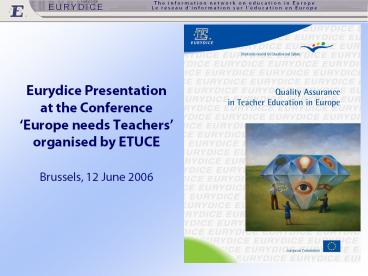Eurydice Presentation at the Conference - PowerPoint PPT Presentation
1 / 28
Title:
Eurydice Presentation at the Conference
Description:
3. Accreditation and Evaluation of In-Service. Teacher Education. 1. Scope and Definitions ... Teacher Education. Issues. 1. Specific or general regulations on ... – PowerPoint PPT presentation
Number of Views:24
Avg rating:3.0/5.0
Title: Eurydice Presentation at the Conference
1
Eurydice Presentation at the Conference
Europe needs Teachers organised by ETUCE
Brussels, 12 June 2006
2
Structure of the presentation
1. Scope and Definitions
2. Accreditation and Evaluation of Initial
Teacher Education
3. Accreditation and Evaluation of In-Service
Teacher Education
4. Quality Assurance in Teacher Education
Future Challenges
3
Scope of the study
- 30 countries covered
- Reference year 2005/06
- Teacher education for general compulsory and
upper secondary education (ISCED 1-3) - Evaluation types focusing on the quality of
provision of teacher education
4
Definitions
Evaluation A general process of systematic and
critical analysis leading to judgments and/or
recommendations for improvement regarding the
quality of a (teacher) education institution or
programme.
Accreditation A process by which an institution
or a programme is judged by the relevant
legislative and professional authorities as
having met predetermined standards in order to
provide (teacher) education or training and to
award the corresponding qualifications (where
they exist). The accreditation procedure
presupposes that the programmes or institutions
to be accredited are evaluated.
5
The Accreditation and Evaluation of Initial
Teacher Education
6
Issues
7
Official regulations for the evaluation of
initial teacher education
- General regulations on the evaluation of higher
education apply to the evaluation of teacher
education
- In a few countries, specific regulations do also
exist, and apply only to a particular stage of
initial teacher education
8
(No Transcript)
9
Main features of external evaluation (1)
- Coordinated by an evaluation agency or evaluation
committee or an independent body
- Evaluators are peers and/or evaluation experts
- Evaluation is based on a site visit and on
internal evaluation results
10
Main features of external evaluation (2)
- Legislation on higher education, a list of
evaluation criteria and documents concerning
teacher education are used to draw up evaluation
criteria
- Evaluation criteria cover a variety of issues
11
Frequency of external evaluation
- Evaluation conducted at fixed intervals
- Intervals of 1 to 12 years, fixed or maximum
- Evaluation conducted at variable
intervalsFrequency fixed by the evaluators
and/or the institution evaluated
12
Main features of internal evaluation
- Less regulated than external evaluation
- Coordinated mainly by the management or an
evaluation committee
- Management, academic staff and students
participate
- Internal evaluation criteria are often based on
external evaluation criteria
13
Frequency of internal evaluation
- In most countries, internal evaluation is
undertaken annually
- In some countries, it takes place at least every
3 to 10 years
- Internal evaluation is often linked to external
evaluation. However, in many countries, internal
evaluation occurs more frequently.
14
Use of evaluation results
- Evaluation follow-up
- Impact on (re-)accreditation of programmes or
institutions
- Impact on funding
- Publication of findings
15
(No Transcript)
16
Publication of evaluation findings
- The publication of external evaluation results is
compulsory in 19 countries
- Results are usually available to the management
of institutions and their academic staff and
students
- The publication of internal evaluation results is
compulsory in 6 countries only
17
- The Accreditation and Evaluation of In-Service
Teacher Education
18
Issues
19
Types of providers of in-service teacher education
20
Existence of official regulations
onaccreditation/evaluation
21
External bodies undertaking accreditation/evaluati
on
22
Main procedures of accreditation/evaluation
? 11 countries use all or almost all of the
procedures, mainly on a compulsory basis
23
Scope of accreditation/evaluation
? No regulations on the scope of accreditation
or evaluation in about half of all countries
24
Frequency of accreditation/evaluation
25
Use made of results of accreditation/evaluation
26
Quality Assurance in Teacher Education Future
Challenges
- Scope and players involved
- Acceptance of and trust in evaluation
- Frequency
- The further use of results
27
Thank you for your attention! Visit us and
download our publications at www.eurydice.org
28
Publication of evaluation findings
- The publication of external evaluation results is
compulsory in 18 countries
- Results are usually available to the management
of institutions and their academic staff and
students
- The publication of internal evaluation results is
compulsory in 5 countries only































